What is energy? Energy is the droved from the Greek word "ἐνέργεια" - energeia which means "activity, operation", or from the word "ἐνεργός" - energos, " which means "active, working." There are many forms of energy such as:
- Thermal Energy (Heat)
- Chemical Energy
- Electrical Energy
- Radiant Energy
- Nuclear Energy
- Magnetic Energy
- Elastic Energy
- Sound Energy
- Mechanical Energy
- Light Energy
Thermal energy is associated with the loss or gain of energy that has to do with the change in temperature. Usually it is associated with any form of temperature except absolute zero since absolute zero has no energy whatsoever.
Chemical Energy has to with energy gained or loss given by the interaction between objects that form a chemical reaction.
Electrical Energy has to do with electric energy being converted into other forms of energy, most likely heat.
Radiant Energy is the energy of electromagnetic waves.
Nuclear Energy has to do with energy that is gained or loss through nuclear reactions.
Magnetic Energy is basically the change in electric energy, since it causes a magnetic field.
Elastic Energy is the energy or work needed to compress or expand a spring of some sort.
Sound Energy is the vibrations that occur when something moves, which we perceive as sound.
Light Energy is the energy that gives off light. It can usually be tied in to heat energy since light causes heat.
Saturday, December 11, 2010
Friday, December 3, 2010
Mission Possible: Create a Cannon?
 |
| imma firing ma cannon... |
From projectile motion, we learned that the range (x-distance) is:
From this equation, we know that the best angle should be 45 degrees. Why you ask? Well, since we want the maximum distance, every single factor must be maximized. If you calculate the sin of any angle, you will notice that when sin 90, it is equal to 1, its maximum. Therefore is we sub 45 into the equation for range, it will become sin 90, which is the maximum.
 |
| Do a barrel roll? |
Wednesday, December 1, 2010
Newton's 3 laws on getting hit by an apple...
 |
| A physicophical view point... (Get it?) |
 |
| If Yoshi does it, you know it has to be cool. |
- Inertia. Objects are lazy. So it wants to keep doing whatever it is doing unless there is an external force affected on it. Ex. A ball in space will keep flying, it doesn't want to stop because it is lazy.
- F=ma. Since force is positively related to acceleration, and mass is negatively related to acceleration, the equation F = ma can be formed (a = F/m is another form of zis)
- For every action force, there is an reaction that is equal in the completely opposite direction. When you punch a wall, the impact sends the force into the wall and into your fist. That is why you get hurt. :)
1) Equilibrium
 |
| This diagram increases the tension dramatically... |
When there is completely no motion, and everything is in a state of balance, this is called equilibrium. Usually, you are required to find the tension or the mass of the object. The vertical component of the system is usually Fg which is the force of gravity (also = mg). There is also usually the two tensions given. You should know that T1y + T2y = Fg since all forces should negate each other.
When dealing with these questions, it is essential for you to state your assumptions, this way, the reader will understand your viewpoints.
Assumptions:
- Friction = 0
- Acceleration = 0 (No motion)
- Total Force turns out to be 0
- (If there is tension then T1x = T2x)
- Set positive axis
- No air resistance
- No movement at all
- No movement at all
2) Incline
 |
| Ramping up the difficulty... |
When an object is at a state or rest or moving on a surface that is not horizontal. The only new component about this is the force of friction. As previously explored, the force of friction, if not given, is m(miu)Fn (Force of Normal) The usual components in the free body diagram is the gravity (Fg), the force of normal (or surface, = Fn) and friction (f).
When doing these sort of questions, don't forget to set a positive axis (Usually slanted along with the slope of the ramp).
Assumptions:
- Friction cannot = 0
- No air resistance
- Positive axis is usually in the direction of motion
- Fn = Fg, since the object on the ramp is not flying up or down
- Fn is perpendicular to the incline
- No movement in the y-direction
- No movement in the y-direction
3) Pulley
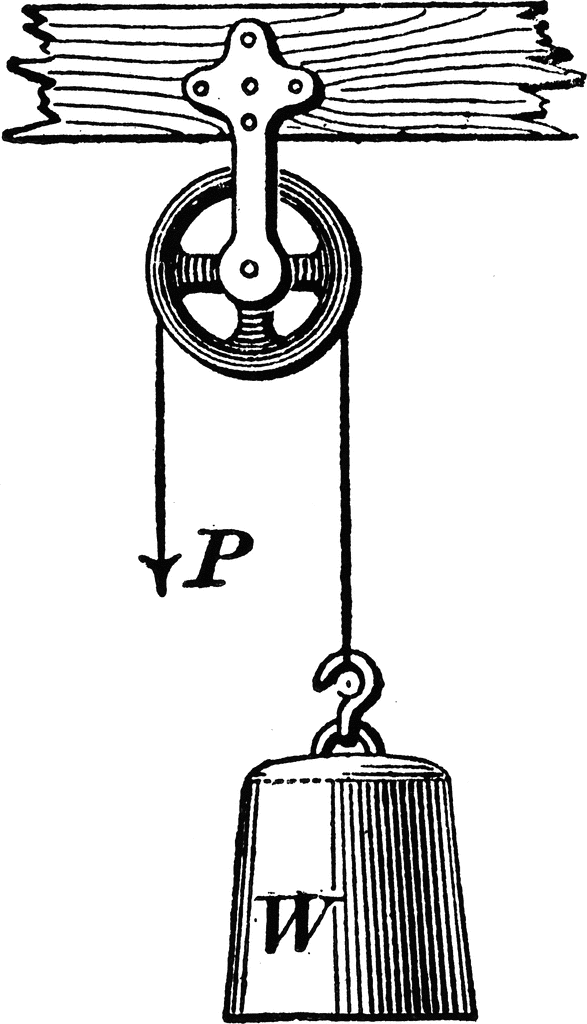 |
| It really pulls you in.. |
When an object is pulling or being pulled by another object through tension, it is probably in a system involving a pulley. As you can see, the pulley should consist of a weight on both sides of the wheel thingy thing. Since both ends of the pulley are putting their masses on the string thing, the tension is the same. When doing pulley questions, don't forget to make 2 free body diagrams when required since there is acceleration and forces in different directions
Assumptions:
- No friction on the ropes or the pulley itself
- No air resistance
- a does not = 0
- T1 = T2
- a1 = a2
- Positive axis in the direction of acceleration
- 2 Free Body diagrams
- In some cases, no movement in the x or y - direction
- In some cases, no movement in the x or y - direction
4) Train
 |
| All on board the train to physics land.... What do you mean I should get a doctor.....? |
Assumptions:
- No friction, or in other cases yes friction
- No air resistance
- Cables or birds that hit the train have no mass
- Positive axis in the direction of acceleration
- Free-body diagrams according to the number of trains
- No movement in the y - direction
- Acceleration cannot = 0, but is constant
Don't forget, if you don't assume, you will get SCREWED!!!!!
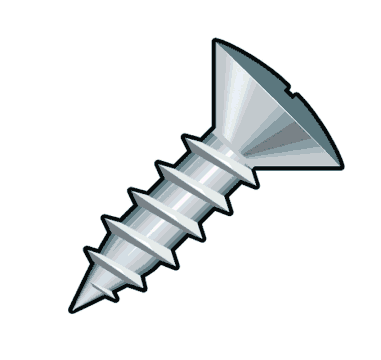 |
| BEWARE THE SCREW!!! |
Monday, November 8, 2010
My favorite, which roller coaster is? (With Yoda accent :D)
 |
| Where is Waldo? |
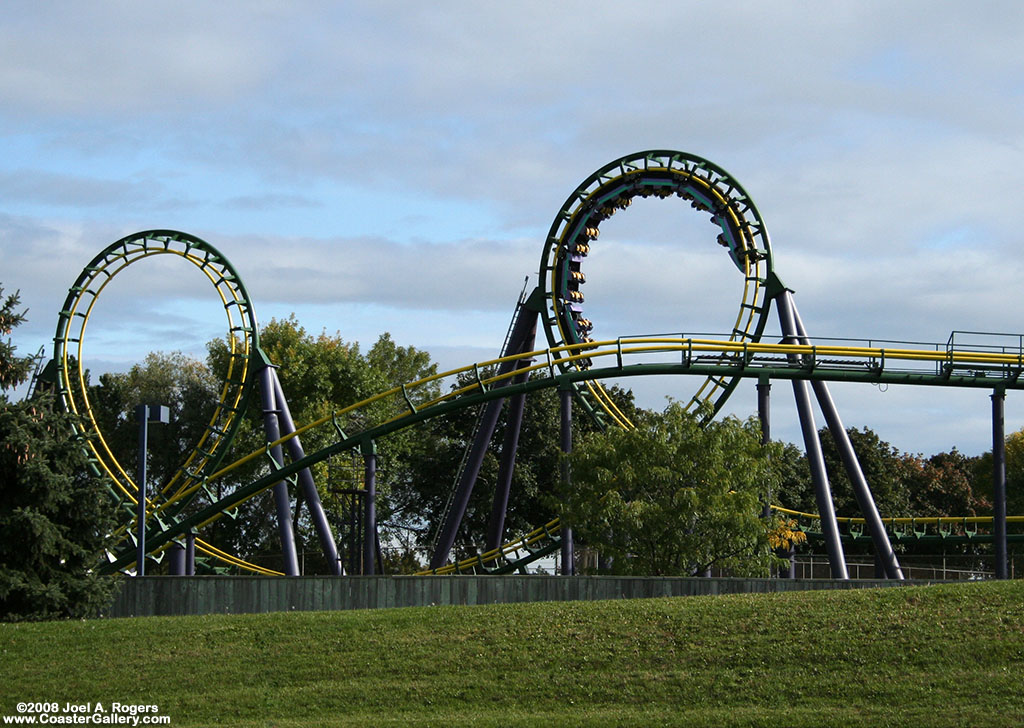 |
| As you can see, the coaster is dragonly-epic :D |
Wednesday, November 3, 2010
Projectile Motion
 |
| You have reached, level 2! |
Previously, we have talked about vectors and the Big 5, which are equations that show the relation between distance, velocity and acceleration. Now, we will LEVEL UP! Projectile motion has to do with the application of vectors and the Big 5 in real life physics.
 |
| THE LEAPING CAT OF PHYSICS! |
Let's say a cat jumps off from a cliff, what are the variables and what are the givens? Since we learned about vectors, we can split up the motion into both a horizontal velocity, and a vertical velocity. The horizontal velocity is constant and has an acceleration of 0 IF there is no air resistance or air in general. Why? Because gravity only affects vertical velocity and nothing hinders it, therefore it is constant. As mentioned before, the vertical velocity will not be constant since there is an acceleration of 9.81m/s^2 (gravity) Also, before the cat jumps, it is at rest, therefore there is a vertical velocity of 0 at first. Assuming that the cat does not go up, and just sideways down the cliff, and that the givens are a horizontal velocity of 100m/s and it falls for 30 seconds before it hits the ground, how far did it fall and how fast was it going before it landed?
 |
| Ay is the vertical speed, Ax is the horizontal speed, and A is the velocity. |
The distance can be easily found by using the equation: D = vt where D is the distance, v is the horizontal velocity, and t is the time. Therefore D = 100m/s x 30 = 3000m. The cat jumped 3000m away. The final velocity is a harder to find though. First, we must find the final vertical speed. at = v2 - v1 is the equation that we will use. If we sub in a, t, and v1, we get 9.81 x 30 = v2 - 0, v2 = 294.3m/s. Now the final velocity can be found by using vector components and the Pythagorean theorem. The final velocity = sqrt(v2^2 + v1^2) = 310.6m/s = 311m/s. Therefore we now know how to find projectile motion. (The easy ones =D)
Thursday, October 28, 2010
How to add Vectors....
How to Add Vectors
 |
| Vectors... |
In order to understand how to add vectors, one must first understand, what is a vector? Vectors are comprised of two main characteristics, the magnitude and the direction. Normally, we mainly talk about the magnitude, which is the size of the vector. The size can be speed, distance, acceleration or any other unit. The direction however is not usually discussed about. The direction can be shown as a degree or as a compass direction. A vector can look like this. In order to add two vectors together, you must consider the 2 factors that were mentioned before, the magnitude and the direction. If you have two vectors that are facing the same direction, for example [E] (East), then you can add their magnitudes together and they are both facing the same direction. If they are facing the opposite directions, for example one of them is facing [E] and the other is facing [W], then you may change the one facing [W] to become – [E] since it is the reverse direction of [E]. After that is done, then adding them is a simple matter. A simple example is the picture on the right. The givens are A = 15m [E], B = 30m [W] and C = 10m [W]. Before we add them together, first we must change the direction of A. As you may recall, in order to invert the direction, we merely add the negative sign in front of the magnitude. Therefore A becomes -15m [W]. Now adding them together is very simple. A + B + C = -15 + 30 + 10 = 25m [E].
 You may wonder, what if they are not complete opposites, what if you had to add a vector facing north with a vector facing east? Well, that is no difficulty whatsoever my young paddlewans. Let’s explain with another example. The graph on the side states that B = 4m [N] while A = 3m [E]. Let’s test your memory; do you remember the Pythagorean Theorem? Well, by using the Pythagorean Theorem, you can find A + B. All you do is find the square root of the sum of “a”, which is A, squared and find the “b”, which is B, squared. You basically get: sqrt(A^2 + B^2) = sqrt(9 + 16) = 25m. WATCH OUT! You may think that you’re done but truth is... IT’S A TRAP! Remember how a vector MUST have both a magnitude and a direction, well, in order to complete A + B, you must find the direction. The direction can be found with trigonometry. First, you label the tail of A (The part of the arrow without the arrow tip) as the origin, then you label the head of B (The part with the arrow tip) as the final point. Now, you use trigonometry to find the angle. Since the tail of A is the origin, think of it on a graph as (0, 0). Therefore, from the graph you realize that A + B is in the positive quadrant.
You may wonder, what if they are not complete opposites, what if you had to add a vector facing north with a vector facing east? Well, that is no difficulty whatsoever my young paddlewans. Let’s explain with another example. The graph on the side states that B = 4m [N] while A = 3m [E]. Let’s test your memory; do you remember the Pythagorean Theorem? Well, by using the Pythagorean Theorem, you can find A + B. All you do is find the square root of the sum of “a”, which is A, squared and find the “b”, which is B, squared. You basically get: sqrt(A^2 + B^2) = sqrt(9 + 16) = 25m. WATCH OUT! You may think that you’re done but truth is... IT’S A TRAP! Remember how a vector MUST have both a magnitude and a direction, well, in order to complete A + B, you must find the direction. The direction can be found with trigonometry. First, you label the tail of A (The part of the arrow without the arrow tip) as the origin, then you label the head of B (The part with the arrow tip) as the final point. Now, you use trigonometry to find the angle. Since the tail of A is the origin, think of it on a graph as (0, 0). Therefore, from the graph you realize that A + B is in the positive quadrant. 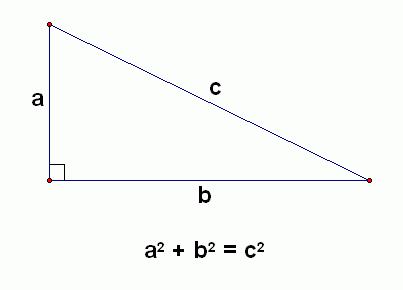 |
| Pythagorean Theorem |
 Now find the trigonometry, more specifically tangent. Using tangent, we can find the angle that A + B forms with the y-axis, which becomes 36.7 degrees. With this, we can get A + B = 5 [N36.7E]
Now find the trigonometry, more specifically tangent. Using tangent, we can find the angle that A + B forms with the y-axis, which becomes 36.7 degrees. With this, we can get A + B = 5 [N36.7E]Calculating two vectors with diagonals may seem hard but they are actually very simple. Now that you know how to find a diagonal vector from two horizontal/vertical vectors, you just split up the diagonal vectors into a horizontal and a vertical vector, add the 4 different vectors together, find the angle and voila, that becomes your new vector.
Wednesday, October 20, 2010
How to derive the equation d = v2(delta)t - 1/2a(delta)t^2
Similar to the other equation, d = v1(delta)t + 1/2a(delta)t^2, the equation can be found from a velocity - time graph. First, you have the same graph with the same points. This time, you will find the same area except that you first find the area of a rectangle formed with v2 and (delta)t subtracted by the triangle above the trapezoid. The area of the rectangle is
Area1 = bh
Area1 = (v2)(delta)t
Now, the area of the triangle can be found with the equation Area2 = bh/2. The base of this equation is (delta)t like previously but the height is the difference between v2 and v1, which becomes v2 - v1. Therefore the equation becomes:
Area2 = 1/2(v2 - v1)(delta)t
Now, in order to find the area of the trapezoid, you must subtract the area of the triangle from the rectangle.Therefore, you get
Area = Area1 - Area 2
Area = v2(delta)t - 1/2(v2 - v1)(delta)t
Now label this equation ♦
Previously in class, we learned that acceleration can be derived from the slope of the velocity graph:
a (acceleration) = (v2-v1)/(delta)t
a(delta)t = (v2 - v1)
Now label this ♣
Now substitute ♣ into ♦
d(Area) = v2(delta)t - 1/2 (a(delta)t)(delta)t
d = v2(delta)t - 1/2a(delta)t^2
Thus you derived the equation d = v2(delta)t - 1/2a(delta)t^2.
How to derive the equation d = v1(delta)t + 1/2a(delta)t^2
 |
| Velocity Graph with points (v1, t1) and (v2, t2) |
Area1 = v1(delta)t
The area of the triangle can be found with the equation Area2 = (bh)/2, where the base is (delta)t and the height is v2 - v1 since you are trying to find the height between v2 and v1. Therefore, your equation is |
| Velocity Graph with areas indicated of the (tri + rect)angles |
Area2 = (v2-v1)(delta)t x 1/2
Area2 = 1/2(v2-v1)(delta)t
Now, let's combine the 2 areas and label it ☺: d(Area) = v1(delta)t + 1/2(v2-v1)(delta)t
Previously in class, we learned that acceleration can be derived from the slope of the velocity graph:
a (acceleration) = (v2-v1)/(delta)t
Now label this ☻ a(delta)t = (v2 - v1)
Now substitute ☻ into ☺: d = v1(delta)t + 1/2(a(delta)t)(delta)t
d = v1(delta)t + 1/2(a (delta)t^2)
d = v1(delta)t + 1/2a(delta)t^2
Thus you derived the equation d = v1(delta)t + 1/2a(delta)t^2.
Thursday, October 14, 2010
HARDCORE Velocity and Acceleration hypothesis?
The relation between the velocity and the acceleration is that the area of the shape that the acceleration forms with the-axis is equal to the displacement of the velocity. For example, if acceleration consists of a line going directly from the origin to point (4,4). One could say that the velocity graph, should it be translated would form a parabola with the displacement of 8 with the curve opening upward. Similarly, the slope of the velocity graph is equal to the acceleration. Should you attempt to find the acceleration from the velocity, you would have to find the instantaneous slope of the parabola and that would give you the acceleration.
The rule however is that if the velocity has a graph with an equation of degree 2, the acceleration must form a graph with an equation of degree1. Similarly, with the velocity is a graph with an equation of degree 5, the acceleration must form a graph with an equation of degree 4. Creating a general rule from this is that if velocity has a graph with an equation of degree n, the acceleration must form a graph with an equation of degree n - 1. This general rule is the basics of derivatives.
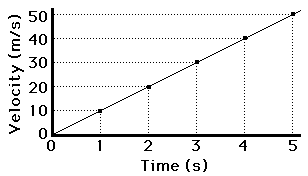 |
| Finding the slope of a velocity graph. |
 |
| Graphs of everything :O |
Tuesday, October 12, 2010
Translating graphs..... to FRENCH!?!?!?!?
Physic Graphs Translated
During the 1st sec, there was no change in the distance; therefore there is a velocity of zero. From the 1st to 3rd sec, there was a constant speed of 1.7m/s east. During the 3rd – 6th sec, there was no change in distance; therefore, a velocity of zero. From the 6th – 7.5 there was a velocity of -2m/s in the opposite direction, west. From then onward, there was no change in distance, therefore velocity as well. Since the velocity was always constant (horizontal line), the acceleration is 0.
From the beginning to the 3rd second, there was a constant change of position heading west. The constant change was 0.5m/second. From the 3rd second to the 4th second, there was no change in distance, therefore a velocity of 0. From the 4th second to the 5th second, there was another constant change of position west at the rate of 1m/s. From the 5th – 7th second, there was no change in distance so there must be a velocity of 0. From the 7th second to the end (10th second) the distance goes to 3m in 3 seconds, which equates to 0.83333 m/s east. Throughout the chart, the velocity was always at a constant rate parallel to the x-axis, therefore the acceleration throughout is 0.
There is a velocity of 0 up to the 2nd second. From the 2nd second to the 5th second, there is a velocity of 0.5m/s. Since there is a constant velocity of 0.5m/s, the distance will increase from 0.5m on the first second, all the way to 1.5m on the 5th second. From the 5th second up to the 7th second, there is a velocity of 0, and the distance does not change. At the 7th second, there is a sudden velocity of -0.5m/s, which signifies a change of 0.5m/s in the opposite direction. Starting at 1.5m/s the distance will constantly decrease for 3 seconds. 3s x 0.5m/s = 1.5m. The final distance will be 1.5 m. The acceleration is still 0 because of the fact that the velocity stays at a constant rate: in the beginning, the velocity is 0, then the velocity stays at 0.5m/s, then changes back to 0, then finally stays at -0.5ms. Therefore there is no acceleration.
From the 1st second to the 4th second, there is a constant change of velocity. The velocity increases by 1/8 or 0.125m/s every second. The distance can be calculated by measuring the velocity of each second and adding them together. At the 4th second all the way to the 6th second, there is a constant velocity of 0.4m/s. All you do is add 0.5m/s to the distance every second. At the 6th second, the velocities reverses from going east to going west at a rate of 0.4m/s for 3 seconds. Since you are moving in the opposite direction, you subtract 0.4m from the distance every second. Finally from the 9th second to the 10th second, there is a velocity of 0 and the distance does not change. Since there is a constant change in the velocity, the slope of the change becomes the acceleration. The slope of the constant rise is 2; therefore the acceleration is 2m/s2. From there onward, the velocity is either 0 or has a slope of 0 therefore there is no acceleration.
From the start to the 2 and 3/4th of a second, there is a constant rise in distance. The constant rise becomes the velocity, of 0.1666. From that point to the 6 and 1.2th of a second, there is no change in distance, therefore a velocity of 0. Finally, from the 6 and 1/2th of a second to the end (10th second) there is a constant rise of distance at a rate of 0.4m/s, which is the velocity. The acceleration is still 0 because the velocity is either on the x-axis or parallel to the x-axis.
 |
| During and after the 6th second, the distance is the same as the acceleration |
Though this graph may be slightly hard to distinguish, it is relatively easy. From the beginning to the 3rd second, there is a constant velocity of 0.1666m/s, therefore an increase in the distance. From that point on till the 6 and a half second, there is a constant velocity of -0.1666m/s, which means that there is a decrease in the distance at a rate of 0.1666m every second. Finally, until the end there is a velocity of 0, which means that there is no change in distance. The acceleration may vary according to how you interpret it, but assuming that the slight curve is intentional, there is a slight acceleration of 0.3333m/s and acceleration again of 0.1666m/s. The first acceleration is in the negative region because the velocity is changing from positive to negative, therefore a slope downward. The left hand arrow pose shows that the acceleration must therefore be negative.
By: Kingeon Tsang
Friday, October 1, 2010
The King-Young Motor
 |
| The Right-Hand Rule #3, it really sticks out... |
 |
| What we hoped for our experiment to turn out to... I guess it's impossible... |
 |
| Suyoung + Kingeon = UBER PRO H4X0R LEECHERS |
Wednesday, September 22, 2010
My Right Hand rules?
Right-Hand Rule #1:
The Right-Hand Rule #1 is used to find the magnetic field or the conventional current of an electrically charged object. First, you do the thumbs up hand signal. Then, you point your thumb in the direction that the positive energy is traveling. So if the positive current is travelling from top to bottom, then you point your thumb downward, and vice versa. After your thumb is well pointed, you do the "CAT CLAW TECHNIQUE", where you scratch forward with your other 4 fingers while making a cat meowing sound. The movement of your 4 fingers going forward is the direction of the magnetic field. For example, if your right thumb is pointing down and you do the "CAT CLAW TECHNIQUE" and you will find out that the magnetic field goes clockwise. Similarly, if you know the direction of the magnetic field and not the current direction, you curl your finger in the direction of the magnetic field. For example, if the magnetic field goes counter-clockwise, your thumb should be pointing up. The direction at which your right thumb is pointing at is the direction in which the positive electric flow is traveling.
Right-Hand Rule #2
The Right-Hand Rule # is used to find the magnetic orientation or the direction of current of the electrically charged object. First, you do the thumbs up hand signal again with your right hand. This time, you curl your fingers in the direction of the current flow of a coil. If the current is spiraling up the coil in a clockwise motion, then you position your 4 fingers to curl in a clockwise motion. Your thumb then indicates which way is the north magnetic pole and which way is the south magnetic pole. If your thumb points up, your magnetic north is that way. If your thumb points left, your magnetic north is that way. You can also do this in reverse, similar to the Right-Hand Rule #1, all you do is point your thumb to the direction of North magnetic pole and do the "CAT CLAW TECHNIQUE", the curling of your fingers should show you the direction of the current flow.
| Thumb up! |
| Cat claw technique at it's finest. |
| Magnetically attracting..... not literally.... |
Right-Hand Rule #2
 |
| Your right hand will never be this fun. |
Monday, September 20, 2010
Criticisms of page 582 - 592.......
 |
| I artz a magnet and not a horseshoe..... I hope..... |
- A magnetic field is the distribution of a magnetic force in the area surrounding the magnet. There are two different magnetic characteristics of the electric fields, north and south.
 |
| Magnetic field + Flashy lights |
 |
| Interaction between magnets... |
- Similar magnetic poles such as north and north, south and south, repel one another, which means that they push each other away. Dissimilar poles such as north and south, or south and north attract one another, which means that they pull each other together. However, these features have more or less force depending on the distance, so two close magnets either repel or attract each other with great strength, but weakly repel or attract each other.
 |
| Earth's magnetic field + colours |
- Magnetic forces are not limited to only 2 magnets, but magnets can also attract certain metals that are not magnets. Magnets can attract certain metals such as iron, nickel, cobalt or mixtures of these metals. The special name for these metals are called ferromagnetic metals, magnets themselves are ferromagnetic metals.
 |
| Oersted's Principle, those circles are compasses.... |
-The domain theory of magnets is that all large magnets are made up of smaller and rotatable magnets, called dipoles, which can attract/repel other dipoles close to it. A magnetic domain is produced when the dipoles line up.
-Oersted’s Principle states that a circular magnetic field is produced around the conductor when charge is moving through it.
 |
| Right Hand Rule #1, It's always right... hahaha.... |
- The Right-hand rule #1 states that when you grasp a conductor with the thumb of your right hand pointing in the direction of the positive current flow, our curved fingers point in the direction of the magnetic field.
- The Right-hand rule #2 (For conventional current flow) states that when you grasp a coiled conductor with your hand and your curved fingers in the direction of the positive current flow, your thumb will point in the direction of the magnetic field inside the coil.
 |
| Right Hand Rule #2.... This is the right way... hahaha... |
- Current in a coil can be measured with the formula B2 = B1 (I2/I1) where B2 and B1 is the strength of the magnetic field and I1 and I2 are the currents before, and the increased currents respectively through the conductor.
- The number of turns in a coil can be determined with the formula B2 = B1 (n2/n1) where B2 and B1 is the strength of the magnetic field and n1 and n2 are the number of turns in the coil.
- Demagnetization may occur among ferromagnetic materials. Demagnetization is the loss of magnetic strength within ferromagnetic materials. The strength of a magnet can only become so strong and that limit is the maximum strength.
Tuesday, September 14, 2010
10 things I learned from 553 – 563 which I originally thought was 555 – 563 which was cut off... yeah...
 |
| Caution: This sign might shock you... |
-Resistance is the measure of the opposition to flow in the unit ohms (Ω).
- By plotting the relationship between the current and the voltage on a graph, finding the slope of the straight line which is constant, it creates the equation R = V/I.
-R = V/I where R is the resistance in volt/ampere, also known as ohm, named after Georg Simon Ohm, V being the potential difference in volts (V) and I is the current in amperes (A).
-Resistance is affected by many factors, such as length, cross-sectional area, the material, and its temperature. Similarly, the resistor is affected by the thickness of the conductor. If the conductor is thinner, then only a limited amount of electrons/coulombs can pass freely, if the conductor is thicker however, then all the electrons coulombs can move freely.
-Series circuits are circuits that consist of the loads connected one after the other in a single path. Unlike the parallel circuits, there is no second path for the electrons in the current to take. Parallel circuits are circuits that consist of the loads place side by side and arranged so that the electrons or current can travel in multiple pathways.
-Kirchhoff’s current law state that the total amount of current into a junction point of a circuit equals the total current that comes out of that same juncture.
-Kirchhoff’s voltage law states that the total of all electrical potential decreases in any complete circuit loop is the same as any potential increases in that loop. In application to series circuit, Kirchhoff’s voltage law states that the total voltage (VT) is equal to the other voltages combined (V1 + V2 + V3 ...)
 |
| Wow.... that looks positively electrifying.... |
-The formula for the resistance in a series circuit is the total resistance (RT) is equal to all the other resistances added together (R1 + R2 + R3 + R4...) so it writes out to RT = R1 + R2 + R3 + R4...
-The formula for the resistance in a parallel circuit is similar to the formula for the resistance in a series circuit except that 1 is dividing everything. So the formula becomes 1/RT = 1/R1 + 1/R2 + 1/R3 + 1/R4...
Monday, September 13, 2010
Prelab: Using Voltmeter and Ammeter! :O
Name | Symbol | Unit | Definition |
Voltage | V | V | Aka, electrical potential difference is the energy stored when static electric charges are held a certain distance apart. The formula for V is V = E/Q where V is the electric potential difference, in volts, E is the energy required to increase the electric potential of a charge in Joules and Q being the charge itself in coulombs. Voltage can be measured by the use of a voltmeter. |
Current | I | A | The rate of which charge flows past a certain point in a conductor. The current is the movement of electrons, from positive to negative. However, Benjamin Franklin believed that it was actually the movement of positive energy; therefore many physicists based their theories upon the conventional current, Benjamin’s theory of the movement of positive energy. Current can be measured by the use of an ampere. The formula for I is I = Q/t. Where I is the current in amperes, Q is the charge in coulombs, and t is the time in seconds. |
Resistance | R | Ω | The electric resistance is the measure of the opposition of the current flow. It was discovered by Georg Ohm and it is measured in the unit Ohm. The formula for resistance is R = V/I, where R is the resistance in ohms, V is the electric potential in volts and I is the electric current in amperes. |
Power | E | W | Power is the process of energy transfer from one of its many forms to another. Work is related to electric potential difference or voltage because work is also another term for E, the energy. Therefore, the formula for voltage can be rewritten as W(or E) = V/Q. |
Subscribe to:
Posts (Atom)







